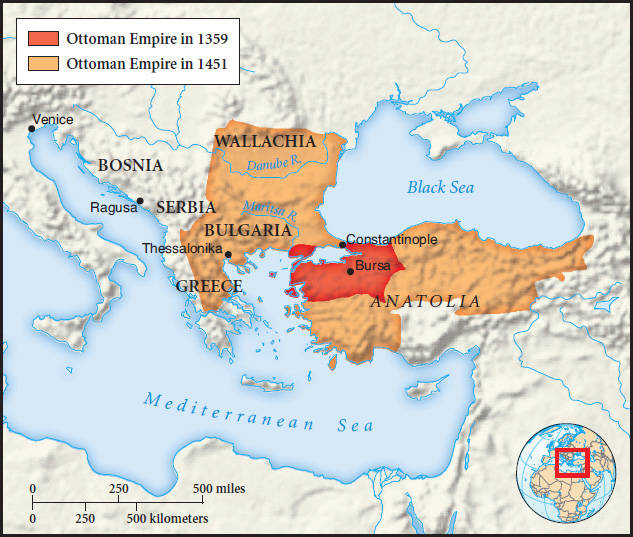The Case of Anatolia
Change
Question
In what ways was Anatolia changed by its incorporation into the Islamic world?
[Answer Question]
At the same time as India was being subjected to Turkic invasion, so too was Anatolia (now modern Turkey), where the largely Christian and Greek-speaking population was then governed by the Byzantine Empire (see Map 9.2, and Map 9.5). Here, as in India, the invaders initially wreaked havoc as Byzantine authority melted away in the eleventh century. Sufi practitioners likewise played a major role in the process of conversion. The outcome, however, was a far more profound cultural transformation than in India. By 1500, the population was 90 percent Muslim and largely Turkic-speaking, and Anatolia was the heartland of the powerful Turkish Ottoman Empire that had overrun Christian Byzantium. Why did the Turkic intrusion into Anatolia generate a much more thorough Islamization than in India?

One factor clearly lies in a very different demographic balance. The population of Anatolia—perhaps 8 million—was far smaller than India’s roughly 48 million people, but far more Turkic-speaking peoples settled in Anatolia, giving them a much greater cultural weight than the smaller colonizing force in India. Furthermore, the disruption of Anatolian society was much more extensive. Massacres, enslavement, famine, and flight led to a sharp drop in the native population. The Byzantine state had been fatally weakened. Church properties were confiscated, and monasteries were destroyed or deserted. Priests and bishops were sometimes unable to serve their congregations. Christians, though seldom forced to convert, suffered many discriminations. They had to wear special clothing and pay special taxes, and they were forbidden to ride saddled horses or carry swords. Not a few Christians came to believe that these disasters represented proof that Islam was the true religion.21 Thus Byzantine civilization in Anatolia, previously focused on the centralized institutions of church and state, was rendered leaderless and dispirited, whereas India’s decentralized civilization, lacking a unified political or religious establishment, was better able to absorb the shock of external invasion while retaining its core values and identity.
The Turkish rulers of Anatolia built a new society that welcomed converts and granted them material rewards and opportunity for high office. Moreover, the cultural barriers to conversion were arguably less severe than in India. The common monotheism of Islam and Christianity, and Muslim respect for Jesus and the Christian scriptures, made conversion easier than crossing the great gulf between Islam and Hinduism. Such similarities lent support to the suggestion of some Sufi teachers that the two religions were but different versions of the same faith. Sufis also established schools, mills, orchards, hospices, and rest places for travelers and thus replaced the destroyed or decaying institutions of Christian Anatolia.22 All of this contributed to the thorough religious transformation of Anatolia and laid a foundation for the Ottoman Empire, which by 1500 became the most impressive and powerful state within the Islamic world.
But the Islamization of Anatolia occurred within a distinctly Turkish context. A Turkish language, not Arabic, predominated. Some Sufi religious practices, such as ecstatic turning dances, derived from Central Asian Turkic shamanism (see Visual Source 7.5). And Turkic traditions offering a freer, more gender-equal life for women, common among pastoral people, persisted well after conversion to Islam, much to the distress of the Arab Moroccan visitor Ibn Battuta during his travels among them in the fourteenth century: “A remarkable thing that I saw . . . was the respect shown to women by the Turks, for they hold a more dignified position than the men. . . . The windows of the tent are open and her face is visible, for the Turkish women do not veil themselves.”23 He was not pleased.